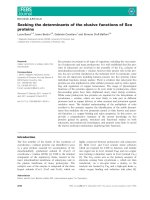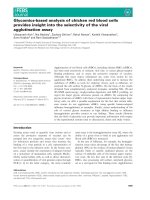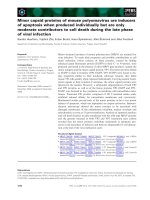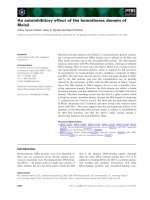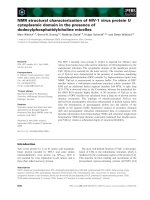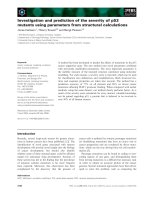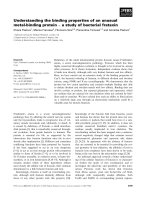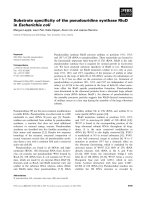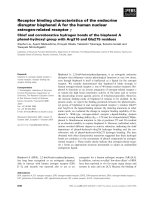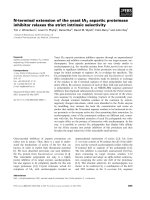báo cáo khoa học: " Evaluating the effectiveness of a tailored multifaceted performance feedback intervention to improve the quality of care: protocol for a cluster randomized trial in intensive care" pps
Bạn đang xem bản rút gọn của tài liệu. Xem và tải ngay bản đầy đủ của tài liệu tại đây (418.94 KB, 10 trang )
Implementation
Science
Evaluating the effectiveness of a tailored
multifaceted performance feedback intervention
to improve the quality of care: protocol for a
cluster randomized trial in intensive care
van der Veer et al.
van der Veer et al. Implementation Science 2011, 6:119
(24 October 2011)
STUDY PROT O C O L Open Access
Evaluating the effectiveness of a tailored
multifaceted performance feedback intervention
to improve the quality of care: protocol for a
cluster randomized trial in intensive care
Sabine N van der Veer
1*
, Maartje LG de Vos
2,3
, Kitty J Jager
1
, Peter HJ van der Voort
4
, Niels Peek
1
,
Gert P Westert
2,5
, Wilco C Graafmans
6
and Nicolette F de Keizer
1
Abstract
Background: Feedback is potentially effective in improving the quality of care. However, merely sending reports is
no guarantee that performance data are used as input for systematic quality improvement (QI). Therefore, we
developed a multifaceted intervention tailored to prospectively analyzed barriers to using indicators: the
Information Feedback on Quality Indicators (InFoQI) program. This program aims to promote the use of
performance indicator data as input for local systematic QI. We will conduct a study to assess the impact of the
InFoQI program on patient outcome and organizational process measures of care, and to gain insight into barriers
and success factors that affected the program’s impact. The study will be executed in the context of intensive care.
This paper presents the study’s protocol.
Methods/design: We will conduct a cluster randomized controlled trial with intensive care units (ICUs) in the
Netherlands. We will include ICUs that submit indicator data to the Dutch National Intensive Care Evaluation (NICE)
quality registry and that agree to allocate at least one intensivist and one ICU nurse for implementation of the
intervention. Eligible ICUs (clusters) will be randomized to receive basic NICE registry feedback (control arm) or to
participate in the InFoQI program (intervention arm). The InFoQI program consists of comprehensive feedback,
establishing a local, multidisciplinary QI team, and educational outreach visits. The primary outcome measures will
be length of ICU stay and the proportion of shifts with a bed occupancy rate above 80%. We will also conduct a
process evaluation involving ICUs in the intervention arm to investigate their actual exposure to and experiences
with the InFoQI program.
Discussion: The results of this study will inform those involved in providing ICU care on the feasibility of a tailored
multifaceted performance feedback intervention and its ability to accelerate systematic and local quality
improvement. Although our study will be conducted within the domain of intensive care, we believe our
conclusions will be generalizable to other settings that have a quality registry including an indicator set available.
Trial registration: Current Controlled Trials ISRCTN50542146
* Correspondence:
1
Department of Medical Informatics, Academic Medical Center, PO Box
22660, 1100 DD Amsterdam, the Netherlands
Full list of author information is available at the end of the article
van der Veer et al. Implementation Science 2011, 6:119
/>Implementation
Science
© 2011 van der Veer et al; licensee BioMed Central Ltd. This is an Open Access article distributed under the terms of the Creative
Commons Attri bution License ( which permits unrestricted use, distribution, and
reproduction in any medium, provided the original work is proper ly cited.
Background
To systematically monitor the quality of care and develop
and evaluate successful improvement interv entions, data
on clinical performance are essential [1,2]. These perfor-
mance data are often based on a set of quality indicators,
ideally combining measures of structure, process, and out-
comes of care [3,4].
Also within the domain of intensive care , several indi-
cator sets have been developed [5-9], and nume rous
quality registries have been established worldwide to rou-
tinely have indicator data available on the performance of
intensive care units (ICUs) [10-13]. In the Netherlands,
the National Intensive Care Evaluation (NICE) quality
registry was founded in 1996 by the Dutch intensive care
profession with the aim to systemati cally and continu-
ously monitor, assess, and compare ICU performance,
and to improve the quality of ICU care based on the out-
come indicators case-mix adjusted hospital mortality and
length of ICU stay [13]. In 2006, this limited core data set
of outcome indicators was extended to a total of eleven
structure, pr ocess, and o utcome indicators, adding items
such as nurse-to-pati ent rat io, glucose regul ation , dura-
tion of mechan ical ventilation, and incide nce of severe
pressure ulcers. The extended set was de veloped by the
Netherlands Society for Intensive Care (NVIC) in close
collaboration with the NICE foundation [7].
Besides facilitating data collection and analyses, NICE-
like most quality registries-also sends participants period-
ical feedback reports on their performance over time and
in comparison with other groups of ICUs. Although feed-
back is potentially effective in improving the quality of
care [14-16], merely sending feedback report s is no guar-
antee that performance data are used as input for sys-
tematic quality improvement (QI).
Problem: barriers perceived by health care professionals
to using performance feedback for systematic quality
improvement
Previous systematic reviews reported potential barriers at
different levels to using performance data for systematic
improvement of health care, e.g., insuf ficient data quality,
no acknowledgement of the room for improvement in
current practice, or lack of resources to implement qual-
ity interventions [15,16]. The results of a validated ques-
tionnaire completed by 142 health care professionals
working at 54 Dutch ICUs confirmed that such barriers
also exist within the context of intensive care [17]. As
suggested by others [18,19], we translated these prospec-
tively iden tified barriers into a m ultifaceted QI interven-
tion using input from future users, expert knowledge,
and evidence from literature. The table in ‘Additional file
1’ contains all barrie rs identified and h ow they are tar-
geted by the intervention. We named the resulting QI
program InFoQI (
Information Feedback on Quality
Indicators). InFoQI was developed and will be evaluated
within the c ontext of intensive care and the Dutch NICE
registry. By targe ting the potential barriers to using per-
formance feedback as input for systematic QI activities at
ICUs, the InFoQI program ultimately aims to improve
the quality of intensive care.
Study objectives
The study as proposed in this protocol aims to evaluate
the effect of the tailored multifaceted feedback interven-
tion on the use of performance indicator data for systema-
tic QI at ICUs. Specific objectives include:
1. To assess the impact of the InFoQI program on
patient outcome and organizational process mea-
sures of ICU care.
2. To gain i nsight into the barriers a nd success fac-
tors that affected the program’s impact.
3. The InFoQI program was designed to overcome
the previously identified barriers to using perfor-
mance indicator data as input for local QI activities.
Based on this assumption we hypothesize that ICUs
participating in the InFoQI program will improve the
quality o f their care significantly more than ICUs
receiving basic feedback from the NICE registry.
The results of this study will inform those involved in
providing ICU care on the feasibility of the InFoQI pro-
gram and its a bility to accelerate systematic, local QI at
ICUs. More in general, we believe that our results might
be of interest to clinicians and organizations in any set-
ting tha t use a quality re gistry including performance
indicators t o continuously monitor and improve the
quality of care.
Methods
Study design
We will execute a cluster randomize d controlled trial to
compare facilities participating in the InFoQI program
(intervention arm) to facilities receiving basic feedback
from the NICE registry (control arm). Because the InFoQI
program will be implemented at the facility rather than
individual level, a cluster randomized trial is the preferred
design for the evaluation of the program’seffectiveness
[20]. Like most trials aimed at evaluating organizational
interventions, our study is pragmatic [21]. To apply to cur-
rent standards, the study has been designed and will be
reported in accordance with the CONSORT statement
[22] and the appropriate extensions [23,24].
Setting
The setting of our study is Dutch intensive care. In the
Netherlands, virtually all 94 ICUs are mixed medical-
surgical closed-format units, i.e., units with the intensivist
van der Veer et al. Implementation Science 2011, 6:119
/>Page 2 of 9
as the patient’s primary attending physician. The units are
a mixture of academic, teaching, and nonteaching settings
in urban and nonurban hospitals. In 2005 , 8.4 ad ult ICU
beds per 100,000 population were available, and 466
patients per 100,000 population were admitted to the ICU
that year [25]. Currently, a repres entative sample of 80
ICUs-covering 85% of all Dutch ICUs-voluntarily submit
the limited core data set to the NICE registry, a nd 46
of them collect the complete, extended quality indicator
data set.
At the NIC E coordination center, dedicated d ata man-
agers, software engineers, and a coordinator are responsi-
ble f or routine processing, storing, checking, and
reporting of the data. Also, for the duration of the study,
two researchers will be available to provide the InFoQI
program to ICUs in the intervention arm. The availability
of these resources is essential for the feasibility of o ur
study.
Selection of participants
All 46 ICUs that participate in NICE and (are pre paring
to) submit data to the registry on the extended quality
indicator set will be i nvited to participate in our study.
They should be willing and able to allocate at least two
staff members for an averag e of four hours per month to
be involved in the study. The medical manager of the ICU
must sign a consent form to formalize the or ganization’s
commitment.
All patients admitted to participating ICUs during the
study period will be i ncluded in the analyses. However,
when evaluating the impact on patient outcomes, we will
exclude admissions based on the Acute Physiology and
Chronic Health Evaluation (APACHE) IV e xclusion cri-
teria [26], as well as admissions following cardiac surgery,
patients who were dead on admission, and admissions
with any of the case mix variables missing.
Control arm: basic feedback from the NICE registry
The ICUs allocated to the control arm will be treated as
‘regular ’ NICE participants. This implies they will receive
basic quarterly and annual feedback reports on the regis-
try’s core outcome indicators case-mix adjusted hospital
mortality and length of ICU stay. In addition, they will be
sent similar, but separate, basic quarterly and annual feed-
back reports containing data on the extended in dicator
set. Also, support by the NICE data managers is available
and includes data quality audits, support with data collec-
tion, and additional data analyses on request. Furthermore,
they are invited to a yearly discussion meeting where they
can share experiences with other NICE participants.
Intervention arm: the InFoQI program
ICUs assigned to the intervention arm, i.e., participating in
the InFoQI program, will receive the same intervention as
the control arm, but extended with more frequent and
more comprehensive feedback, a local, m ultidisciplinary
QI team, and two educational outreach visits (Table 1).
From the prospective barriers analysis, it appeared that
many barriers concerned the basic NICE feedback reports.
To target the lack of case-mix correction and lack of infor-
mation to initiate QI actions, the basic quarterly report
will be replaced by an extended, comprehensive quarterly
report that facilitates comparison of an ICU’s performance
with that of other ICUs, e.g.,byprovidingthemedian
length of ICU stay for elective surgery admissions in simi-
lar-sized ICUs as a benchmark. To increase the timeliness
and intensity of reporting, we also developed a monthly
report focusing on monitoring an ICUs’ own performance
over time to facilitate local evaluation of QI initiatives, e.g.,
by providing Statistical Process Control (SPC) charts [27].
To decrease the level of data aggregation, both the
monthly and quarterly reports contain data at the level of
individual patients, e.g., a list of unexpected non-survivors
(i.e., patients who died despite their low risk of mortality).
The table in ‘Additional file 2’ summarizes the content of
the reports.
ICUs in th e intervention arm will establish a local QI
team, creating a formal infrastructure at their department
for systematic QI. This team must co nsist of at least one
intensivist and one nurse; a management representative
and a data manager are suggested as additional members.
To target the lack of motivation to change, team members
should be selected b ased on the ir affinity and exper ience
with measuring and improving quality of care and their
capability to convince their colleagues to be involved in QI
activities. The team’s main tasks are described in a proto-
col and include formulating a QI action plan, monitoring
of performance using the feedback report s, and ini tiating
and evaluating QI activities (see Table 1). We estimate the
minimum time investment per team m ember to be four
hours on average per month. This estimation takes into
account all activities prescribed by the InFoQI program
except for the execution of the QI plan. The actual time
spent will depend on the type and number of QI actions
in the plan.
Each ICU will receive two on-site educational ou treach
visits that are aimed at increasing trust in data quality, sup-
porting the QI team members with interpreting their per-
formance data, identifying opportunities for improvement,
and translating them into a QI action plan. The structure
of the visits will be equal for all intervention ICUs and the
template for the action plan will be standardized. All visits
will be facilitated by the same investigators who have a
non-medical background; they have been involved in the
development of the extended NVIC indicator set and have
several years of experience with optimization of organiza-
tional processes at the ICU. Having non-clinicians support-
ing the QI team will make the intervention less intrusive,
van der Veer et al. Implementation Science 2011, 6:119
/>Page 3 of 9
and therefore less threatening to participating units. It also
increases the feasibility of the study, because clinical
human resources are scarce in intensive care.
Outcome measures
We used previousl y collect ed NICE da ta (regarding the
year 2008) t o select outcome measures from the
extended quality indicator set to evaluate the effective-
ness of our intervention. To decrease the probability of
finding positive results by chance as a result of multiple
hypothesis testing [28], we limited our primary endpoints
to a combination of one patient outcome and one organi-
zational process measure. We selected the indicators that
showed the largest room for improvement, i.e., the largest
difference between the average of top-performing centers
and the average of the remaining centers [29].
Primary outcome measures will be:
1. Length of ICU stay (ICU LOS); this will be calcu-
lated as the difference in days between the time of ICU
discharge and time of ICU admission. To account for
patients being discharged too early, the length of stay
of the first ICU admission will be prolonged with the
length of stay of subsequent ICU readmissions within
the same hospital admission.
2. Proportion of shifts with a bed occupancy r ate
above 80%; this threshold is set by t he NVIC in their
national organizational guideline for ICUs [30]. W e
will calculate the bed o ccupancy rate as the maxi-
mum number of patients admitted simultaneously
during an eight-hour nursing shift divided by the
number of operatio nal beds in that same shift. A bed
will be defined as ‘ operational’ when it is fitted with
monitoring and ventilation equipment and scheduled
nursing staff.
Secondary outcome measures will be all-cause, in-hos-
pital mortality of ICU patients, duration of m echanical
ventilation, proportion of glucose measurements outside
the range of 2.2 to 8.0 mmol/L, and the proportio n of
shifts with a nurse-to-patient ratio below 0.5.
Data collection
We will use the existing data collection methods as cur-
rently applied by the NICE registry [31]. Most ICUs parti-
cipating in NICE combine manual entry of data using
dedicated software with automated data extractions from
electronic patient records available in, e.g.,theirpatient
data management system. Each month, participants
upload their data from the local, electronic database to the
central, electronic registry database. ICUs in the interven-
tion arm that have not submitted their data at the end of a
month will be reminded by phone, and assisted if neces-
sary. Quarterly reports are provided within ten weeks after
the end of a period, and monthly reports within six weeks.
The NICE registry uses a framework for data quality
assurance [32], includi ng elements like period ical on-site
data quality audits and automated data range and consis-
tency check s. For each ICU, additional data checks for
completeness and accuracy will be performed before, dur-
ing, and after the study period using descriptive statistics.
Sample size calculations
The minimally required number of ICUs participa ting in
the trial was based on analysis of t he NICE registry 2008
data. First, ICUs were ranked by average ICU LOS of their
patients. The anticipated improvement was defined as the
difference in a verage ICU LOS of the 33% top ranked
ICUs (1.28 days) and average ICU LOS among the remain-
ing ICUs (2.11 days), and amounted to a reduction of 0.58
days per patient. A senior intensivist confirmed that this
reduction is considered clinically relevant. Assuming an
average number of 343 admissions per ICU per year, cal-
culations based on the normal distribution showed that
we will need at least 26 ICUs completing the trial to detect
this difference with 80% power at a type I error risk (a)of
5%, taking an estimated intra-cluster corre lation of 0.036
into account. With this number of ICUs, the study will
Table 1 Elements of the InFoQI program (intervention arm)
Element Description
Feedback • monthly report for monitoring ICU’s performance over time
reports • comprehensive quarterly report for benchmarking ICU’s performance to other
groups of ICUs
• sent to and discussed by QI team members
Local QI team • multidisciplinary
• responsible for formulating and executing a QI action plan
• monthly monitoring and discussing of performance using feedback reports
• sharing main findings with rest of ICU staff
Educational outreach visits • on-site (1) at start of study period and (2) after six months
• all QI team members are present; visits guided by principal investigators
• promoting use of Plan-Do-Study-Act cycle for systematic quality improvement
• formulating and evaluating QI action plan based on performance data
van der Veer et al. Implementation Science 2011, 6:119
/>Page 4 of 9
also be sufficiently powered to detect a reduction in
mechanical ventilation duration of 0.75 days per patient
(from 2.96 to 1.75 days). We do not expect to be able to
detect an effect of the intervention on ICU or hospital
mortality.
To determine the required sample size for bed occu-
pancy, shifts with an occupancy exceeding 80% were
counted. This occurred in 44% of all shifts in 2008. Fol-
lowing the same ranking procedure a s described above,
a reduction of 24% was anticipated, and considered
clinically relevant. Power calculations based on the bino-
mial distribution showed that we will need a minimum
of 16 ICUs completing the trial to detect this di fference,
taking an estimated intra-cluster correlation of 0.278
into account.
Randomization
We will randomly allocate ICUs (clusters) to one of both
study arms, stratified by the number of ventilated, non-car-
diac surgery admissions (less than the national median ver-
sus more than the national median), and involvement in a
previous pilot study to evaluate feasibility of data collection
of the NVIC indicator set [7] (involved v ersus n ot involv ed).
Each stratum will consist of blocks with a randomly
assigned si ze of eithe r two or four ICUs (see Figure 1). A
researcher-not involved in the study and blinded to the
identity of the units-will use dedicated software to generate
a randomization scheme with an equal n umber of interven-
tions and controls for each block. The size and the rando-
mization scheme of the blocks will be concealed to the
investigators enrolling and assigning the ICUs. In an email
to the ICU confirming the arm to which they have been
allocated, the researcher that executed the randomization
process will be sent this information in copy as an addi-
tional check on the assignment process. Due to the charac-
ter of the intervention, it will not be possible to blind
participants or the i nvestigators providing the InFoQI
program.
Statistical analysis
For ICUs in the intervention group, the time from rando-
mization to the first outreach visit-with an expected
duration of six to eight weeks- will be regarded as a base-
line period. Follow-up will end three months after the
last report has been sent, assuming this is the average
time required for an ICU to read, discuss, and act on a
feedback report. The expect ed duration for intervention
ICUs will t herefo re be a pproximately fourteen months.
Control ICUs will have a fixed baseline period of two
months, and a follow-up of fourteen months.
To assess the effect of the InFoQI program, the out-
come values measured during the follow-up period will
be compared between both study arms. To assess the
effect of the program on length of stay, we will perform a
survival analysis of time to alive ICU discharge with
dying at the ICU as a competing risk [33], and adjusting
for patient demographics, severity of illness during first
24 hours of admission, a nd adm ission ty pe. To account
for potential correlation of outcomes within ICUs, we
will use generalized estimation equa tions with exchange-
able correla tion [34-36]. The same procedure will be
used to analyze duration of mechan ical ventilat ion. For
all-cause mortality, logistic regression analysis will be
used, adjusting for sever ity of illness at ICU admission by
using the APACHE IV risk prediction model [26].
To assess the effect of the intervention on the propor-
tion of shifts with a bed o ccupancy rate above 80%,
shift-level occupancy data (0 for an occupancy rate
below or equal to 80%, 1 for a rate above 80%) will be
analyzed with logistic regression analysis. In this case,
generalized estimation equations with an autoregressive
correlation structure will be used to account for the
longitudinal nature of shift occupancy observations. The
same pro cedure will be followed to analyze the propor-
tion of shifts with a nurse-to-patient ratio below 0.5.
To assess the effect on the proportion of out-of-range
glucose measurements, multi-level logistic regression
analysis will be performed where subsequent glucose
measurements on the same patient are treated as time
series data, and both patient-level and ICU-level inter-
cept estimates ar e used to account for potential correla-
tion of measurements within patients and within ICUs.
Process evaluation
We will complement the quantitative trial results with the
results from a pr ocess evaluation to gain insight into the
barriers and suc cess factors that a ffected the program’ s
impact [37]. We will determine the actual exposure to the
InFoQI progr am by asking all members of the local QI
teams to record the time they have invested in the differ-
ent study activities. We will also investigate the experi-
ences of those exposed, and evaluate which of the barriers
identified before the start of the program were ac tually
solved, and if any other unknown barriers affected the pro-
gram’s impact; this might include barriers at the facility
level as well as at t he indi vidual level. Data will be col-
lected by sending an electronic questionnaire to all QI
team members at the end of the study period. They will be
asked to rate on a 5-point Likert scale to what extent they
perceived certain barriers to using the InFoQI program for
quality improvement at their ICU. In addition, we will
invite delegates of the local QI teams for a focus group to
dis cuss in more detail their experiences with the InFoQI
program and the barriers they perceived.
Ethics
The Institutional Review Board (IRB) of the Academic
Medical Center (Amsterdam, the Netherlands) informed
van der Veer et al. Implementation Science 2011, 6:119
/>Page 5 of 9
us that formal IRB approval and patient consent was not
deemed necessary due to the focus of the InFoQI program
on improving organizational processes; individual patients
will no t be directly involved. Additionally, in the Nether-
lands there is no need to obtain consent to use data from
registries that do not contain patient-identifying
ICUs assessed for eligibility
Stratification *
Block randomization
Baseline measurement
Baseline measurement
Allocation to intervention A
(intervention arm)
Allocation to intervention B
(control arm)
Participation in the InFoQI
program
Receiving basic feedback from
the NICE registry
Follow-up measurement
Follow-up measurement
Process evaluation
Figure 1 Study flow . * Stratification was based on size (more/less than the n ational median number of ventilated, non-cardiac surgery
admissions) and involvement (yes/no) in a pilot to evaluate feasibility of indicator data collection.
van der Veer et al. Implementation Science 2011, 6:119
/>Page 6 of 9
information, as is the case in the NICE registry. The NICE
foundation is officially registered according t o the Dutch
Personal Data Protection Act.
Discussion
This paper describes the protocol of a cluster randomized
trial to evaluate the effect of the InFoQI program on the
quality of ICU care and a qualitative process evaluation
to gain insight into the barriers and success factors that
affected the program’s impact. The program-t ailored to
prospectively identified barriers and fa cilitators-consists
of comprehensive feedback reports, establishing a local,
multidisciplinary QI team, and educational outreach vis-
its. We expect that this multifaceted intervention will
improve the quality of ICU care by enabling ICUs to
overcome known barriers to using performance data as
input for local QI activities.
Strengths and weaknesses of the study design
In our study, we used the pr eviously developed NVIC
extended indicator set as the basis for our feedback inter-
vention. Although the N VIC is the national organization
representing the Dutch intensive care profession, so me
ICUs may still disagree with the relevancy of some of the
indicators in t he set. This would h inder the use of the
feedback as input for local QI activities, potentially
decreasing the effectiveness of the intervention. However,
disagreement with the content of the indicator set was
not identified as a barrier in our prospective barriers ana-
lysis. We will reassess this during the process evaluation.
Building on an existing indicator set also results in a
clear strength of our study, because we are able to use the
data collection methods as currently applied by the NICE
registry. This will increase the feasibility of the InFoQI
program, because el igible ICUs already routinely collect
the necessary data items as a result of their participation
in NICE; participation in the InFoQI program does not
require additional data collection activities. Furthermore,
the data quality assurance framework as applied by NICE
increases the reliability of the data [31,38], and all recom-
mended data quality control methods for QI projects [39]
are being accounted for in our study. This will minimiz e
the probability of missing and erroneous data.
Unfortunately, the design of the study will not allow us
to quantitatively evaluat e the relative effectiveness of the
individual components of the InFoQI program. We con-
sidered a factorial design [40] for a separate evaluation of
the impact of the comprehensive feedback reports and the
outreach visits. However, the strong interconnectedness
between the two elements made this difficult. Further-
more, the program aims to suc cessfully overcome known
barriers to using performance feedback for improving
practice. During the development process of the InFoQI
program, it became apparent that in order to achieve this
a combination of strategies would be required. Also, pre-
vious re views of the literature reported that multifaceted
interventions seem to be more effective than single inter-
ventions [15,16,41]. Therefore, we will primarily focus on
evaluating the effectiveness of the program as a whole; yet,
the process evaluation will provide us with qualitative
information on how and to what extent each program ele-
ment might have contributed to this effectiveness.
As for the participants in our study, only ICUs that par-
ticipate in the NICE registry, are capable of submitting
indicator data, and agree to allocate resources to establish
a local QI team will be eligible for inclusion. These cri-
teria may lead to the selection of a non-representative
sample of ICUs, because eligible facilities are less likely to
be understaffed and more likely to have information
technology (IT) support to facilitate routine collection of
NICE data. This will not affect the internal validity of our
results, because both study arms will consist of these
early adopters. Moreover, the ‘ earliest adopters’-i.e.,the
ICUs involved in the indicator pilot study [7]-should be
equally d istributed between intervention and control
group a s a result of our stratification method. However,
the generalizability o f our findings will be limited to
ICUs that are motivated and equipped t o systematically
monitor and improve the quality of the care they deliver.
Nevertheless, as the number of ICUs participating in
NICE is rapidly i ncreasing, IT in hospitals is expanding,
and applying QI principles is becoming more common in
health care, we believe that this requirement will not
reduce the relevancy of our results for future ICU
practice.
Relation to other studies
The effectiveness of feedback as a QI strategy has often
been evaluated, as indicated by the large number of
included studies in systematic reviews on this subject
[14,15]. However, the number of studies comparing the
effect of feedback alone with the effect of f eedback com-
bined with other strategies was limited and relatively few
evaluations regarded the ICU domain [14,42].
Previous before-after studies found a moderate effect of
performance feedback [43] and of multidisciplinary Q I
teams [44] on the qualit y and costs of ICU care. How-
ever, many have advocated the need for rigorous evalua-
tions using an external control group to evaluate the
effect of QI initiatives [45-47], with the clu ster rando-
mized trial usu ally being the preferred method [ 48,49].
There have been cluster RCTs in the ICU domain that
evaluated a multifaceted intervention with audit a nd
feedback as a basic element [50-52]. Some of them were
highly successful in increasing adherence to a specific
evidence-based treatment, such as the delivery of
van der Veer et al. Implementation Science 2011, 6:119
/>Page 7 of 9
surfactant therapy to neonates [51] and semi-recumbent
positioning to prevent ventilator-associated pneumonia
[50]. Our study will adopt a similar approach, combining
feedback with other strategies to establish change. Never-
theless, the InFoQI program will not focus on pr omoting
the uptake of one specific type of practice. Instead, we
assume that: an ICU will be prompted to modify practice
when they receive feedback on their performance being
low or inconsistent with that of other ICUs; the members
of the QI team are capable-with support of the facilita-
tors-to formulate effective actions based on this feedback;
and the resulting customized QI plan will contain QI
activities that are considered important and f easible
within the local context of the ICU. With the process
evaluation, we will learn if these assumptions were
correct.
Expected meaning of the study
The results of this study will inform ICU care providers
and managers on the feasibility of a tailored multifaceted
performance feedback intervention and its ability to accel-
erate systematic, local QI activities. However, the results
will also be of int erest to other settings where national
quality registries including performance indicators are
used for continuous monitoring and improving care.
Furthermore, the quantitative effect measurement together
with t he qualitative data from the process evaluation will
contribute to the knowledge on ex isting barriers to using
indicators for improving the quality of care and how they
can be effectively overcome.
Additional material
Additional file 1: Barriers to using performance data and how they
are targeted The prospectively identified barriers to using performance
data and how they are targeted by the feedback intervention
Additional file 2: Content of the feedback reports Summary of the
content of the quarterly and monthly InFoQI feedback reports
Acknowledgements
We thank all ICU clinicians and managers that provided input for the
development of the intervention. We also acknowledge Eric van der Zwan
and Winston Tjon Sjo e Sjoe for their technical assistance in developing the
feedback reports.
Author details
1
Department of Medical Informatics, Academic Medical Center, PO Box
22660, 1100 DD Amsterdam, the Netherlands.
2
Scientific Centre for
Transformation in Care and Welfare (Tranzo), University of Tilburg, PO Box
90153, 5000 LE Tilburg, the Netherlands.
3
Centre for Prevention and Health
Services Research, National Institute for Public Health and the Environment,
PO Box 1, 3720 BA Bilthoven, the Netherlands.
4
Onze Lieve Vrouwe Gasthuis,
Department of Intensive Care, PO Box 95500, 1090 HM Amsterdam, the
Netherlands.
5
IQ Scientific Institute for Quality of Healthcare, UMC St
Radboud, PO Box 9101 - 114, 6500 HB Nijmegen, the Netherlands.
6
Directorate General for Health and Consumers, European Commission, B -
1049 Brussels, Belgium.
Authors’ contributions
GW, KJ, MDV, NDK, PVDV, SVDV, and WG had the basic idea for this study
and were involved in the developing the protocol. NP planned the statistical
analysis. SVDV drafted the manuscript. All authors were involved in the
critical revision of the paper for intellectual content and its final approval
before submission.
Authors’ information
NDK is director of the NICE registry. NDK and PVDV are members of the
NICE board. PVDV is chairing the Netherlands Society of Intensive Care
committee on quality indicators.
Competing interests
The authors declare that they have no competing interests.
Received: 21 March 2011 Accepted: 24 October 2011
Published: 24 October 2011
References
1. Langley GJ, Moen RD, Nolan KM, Nolan TW, Norman CL, Provost LP: The
improvement guide: a practical approach to enhancing organizational
performance San Francisco: Jossey-Bass Publishers; 2009.
2. Berwick DM: Developing and testing changes in delivery of care. Annals
of Internal Medicine 1998, 128:651-6.
3. Lilford R, Mohammed MA, Spiegelhalter D, Thomson R: Use and misuse
of process and outcome data in managing performance of acute
medical care: avoiding institutional stigma. The Lancet 2004,
363:1147-1154.
4. Donabedian A: Evaluating the quality of medical care. 1966. Milbank Q
2005, 83:691-729.
5. Kastrup M, von D V, Seeling M, Ahlborn R, Tamarkin A, Conroy P,
Boemke W, Wernecke KD, Spies C: Key performance indicators in
intensive care medicine. A retrospective matched cohort study. J Int Med
Res 2009, 37:1267-1284.
6. Berenholtz SM, Pronovost PJ, Ngo K, Barie PS, Hitt J, Kuti JL, Septimus E,
Lawler N, Schilling L, Dorman T: Developing quality measures for sepsis
care in the ICU. Jt Comm J Qual Patient Saf 2007, 33:559-568.
7. De Vos M, Graafmans W, Keesman E, Westert G, Van der Voort P: Quality
measurement at intensive care units: which indicators should we use?
Journal of Critical Care 2007, 22:267-74.
8. Martin MC, Cabre L, Ruiz J, Blanch L, Blanco J, Castillo F, Galdos P, Roca J,
Saura RM: [Indicators of quality in the critical patient]. Med Intensiva 2008,
32:23-32.
9. Pronovost PJ, Berenholtz SM, Ngo K, McDowell M, Holzmueller C,
Haraden C, Resar R, Rainey T, Nolan T, Dorman T: Developing and pilot
testing quality indicators in the intensive care unit. J Crit Care 2003,
18:145-155.
10. Harrison DA, Brady AR, Rowan K: Case mix, outcome and length of stay
for admissions to adult general critical care units in England, Wales and
Northern Ireland: the Intensive Care National Audit & Research Centre
Case Mix Programme Database. Critical Care 2004, 8:R99-111.
11. Stow PJ, Hart GK, Higlett T, George C, Herkes R, McWilliam D, Bellomo R:
Development and implementation of a high-quality clinical database:
the Australian and New Zealand Intensive Care Society Adult Patient
Database. Journal of Critical Care 2006, 21:133-41.
12. Cook SF, Visscher WA, Hobbs CL, Williams RL, the Project IMPACT Clinical
Implementation Committee: Project IMPACT: Results from a pilot validity
study of a new observational database. Critical Care Medicine 2002,
30:2765-70.
13. Bakshi-Raiez F, Peek N, Bosman RJ, De Jonge E, De Keizer NF: The impact
of different prognostic models and their customization on institutional
comparison of intensive care units. Critical Care Medicine 2007, 35:2553-60.
14. Jamtvedt G, Young JM, Kristoffersen DT, O’Brien MA, Oxman AD: Audit and
feedback: effects on professional practice and health care outcomes.
Cochrane Database Syst Rev 2006, , 2: CD000259.
15. Van der Veer SN, De Keizer NF, Ravelli ACJ, Tenkink S, Jager KJ: Improving
quality
of care. A systematic review on how medical registries provide
information feedback to health care providers. International Journal for
Medical Informatics 2010, 79:305-23.
16. De Vos M, Graafmans W, Kooistra M, Meijboom B, Van der Voort P,
Westert G: Using quality indicators to improve hospital care: a review of
van der Veer et al. Implementation Science 2011, 6:119
/>Page 8 of 9
the literature. International Journal for Quality in Health Care 2009,
21:119-29.
17. De Vos M, Van der Veer SN, Graafmans W, De Keizer NF, Jager KJ,
Westert G, Van der Voort P: Implementing quality indicators in ICUs:
exploring barriers to and facilitators of behaviour change.
Implementation Science 2010, 5:52.
18. Bosch M, van der Weijden T, Wensing M, Grol R: Tailoring quality
improvement interventions to identified barriers: a multiple case
analysis. Journal of Evaluation in Clinical Practice 2007, 13:161-168.
19. Van Bokhoven MA, Kok G, Van der Weijden T: Designing a quality
improvement intervention: a systematic approach. Quality & Safety in
Health Care 2003, 12:215-20.
20. Ukoumunne OC, Gulliford MC, Chinn S, Sterne JA, Burney PG, Donner A:
Methods in health service research. Evaluation of health interventions at
area and organisation level. BMJ 1999, 319:376-379.
21. Thorpe KE, Zwarenstein M, Oxman AD, Treweek S, Furberg CD, Altman DG,
Tunis S, Bergel E, Harvey I, Magid DJ, et al: A pragmatic-explanatory
continuum indicator summary (PRECIS): a tool to help trial designers. J
Clin Epidemiol 2009, 62:464-475.
22. Moher D, Hopewell S, Schulz KF, Montori V, Gotzsche PC, Devereaux PJ,
Elbourne D, Egger M, Altman DG: CONSORT 2010 explanation and
elaboration: updated guidelines for reporting parallel group randomised
trials. BMJ 2010, 340:c869.
23. Campbell MK, Elbourne DR, Altman DG: CONSORT statement: extension to
cluster randomised trials. BMJ 2004, 328:702-708.
24. Zwarenstein M, Treweek S, Gagnier JJ, Altman DG, Tunis S, Haynes B,
Oxman AD, Moher D: Improving the reporting of pragmatic trials: an
extension of the CONSORT statement. BMJ 2008, 337:a2390.
25. Wunsch H, Angus DC, Harrison DA, Collange O, Fowler R, Hoste EA, de
Keizer NF, Kersten A, Linde-Zwirble WT, Sandiumenge A, et al: Variation in
critical care services across North America and Western Europe. Crit Care
Med 2008, 36 :2787-2789.
26. Zimmerman JE, Kramer AA, McNair DS, Malila FM: Acute Physiology and
Chronic Health Evaluation (APACHE) IV: hospital mortality assessment
for today’s critically ill patients. Crit Care Med 2006, 34:1297-1310.
27. Benneyan JC, Lloyd RC, Plsek PE: Statistical process control as a tool for
research and healthcare improvement. Qual Saf Health Care 2003,
12:458-64.
28. Guyatt G, Jaeschke R, Heddle N, Cook D, Shannon H, Walter S: Basic
statistics for clinicians: 1. Hypothesis testing. CMAJ 1995, 152
:27-32.
29. Kiefe CI, Allison JJ, Williams OD, Person SD, Weaver MT, Weissman NW:
Improving quality improvement using achievable benchmarks for
physician feedback: a randomized controlled trial. JAMA 2001,
285:2871-2879.
30. Netherlands Society for Anesthesiology: Richtlijn Organisatie en werkwijze op
intensive care-afdelingen voor volwassenen in Nederland [Guideline
Organisation and working processes of ICUs for adults in the Netherlands]
Alphen aan den Rijn, the Netherlands: Van Zuiden Communications B.V;
2006.
31. Arts D, de KN, Scheffer GJ, de JE: Quality of data collected for severity of
illness scores in the Dutch National Intensive Care Evaluation (NICE)
registry. Intensive Care Med 2002, 28:656-659.
32. Arts DG, De Keizer NF, Scheffer GJ: Defining and improving data quality in
medical registries: a literature review, case study, and generic
framework. J Am Med Inform Assoc 2002, 9:600-611.
33. Putter H, Fiocco M, Geskus RB: Tutorial in biostatistics: competing risks
and multi-state models. Stat Med 2007, 26:2389-2430.
34. Logan BR, Zhang MJ, Klein JP: Marginal models for clustered time-to-
event data with competing risks using pseudovalues. Biometrics 2011,
67:1-7.
35. Donner A, Klar N: Design and analysis of cluster randomization trials in health
research London: Arnold; 2000.
36. Zeger SL, Liang KY: Longitudinal data analysis for discrete and
continuous outcomes. Biometrics 1986, 42:121-130.
37. Hulscher ME, Laurant MG, Grol RP: Process evaluation on quality
improvement interventions. Qual Saf Health Care 2003, 12:40-46.
38. Arts DG, Bosman RJ, de JE, Joore JC, de Keizer NF: Training in data
definitions improves quality of intensive care data. Crit Care 2003,
7:179-184.
39. Needham DM, Sinopoli DJ, Dinglas VD, Berenholtz SM, Korupolu R,
Watson SR, Lubomski L, Goeschel C, Pronovost PJ: Improving data quality
control in quality improvement projects. Int J Qual Health Care 2009,
21:145-150.
40. Montgomery AA, Peters TJ, Little P: Design, analysis and presentation of
factorial randomised controlled trials. BMC Med Res Methodol 2003, 3:26.
41. Bero LA, Grilli R, Grimshaw JM, Harvey E, Oxman AD, Thomson MA: Closing
the gap between research and practice: an overview of systematic
reviews of interventions to promote the implementation of research
findings. The Cochrane Effective Practice and Organization of Care
Review Group. BMJ 1998, 317:465-468.
42. Foy R, Eccles MP, Jamtvedt G, Young J, Grimshaw JM, Baker R: What do we
know about how to do audit and feedback? Pitfalls in applying
evidence from a systematic review. BMC Health Serv Res 2005, 5:50.
43. Eagle KA, Mulley AG, Skates SJ, Reder VA, Nicholson BW, Sexton JO,
Barnett GO, Thibault GE: Length of stay in the intensive care unit. Effects
of practice guidelines and feedback. JAMA 1990,
264:992-997.
44. Clemmer TP, Spuhler VJ, Oniki TA, Horn SD: Results of a collaborative
quality improvement program on outcomes and costs in a tertiary
critical care unit. Crit Care Med 1999, 27:1768-1774.
45. Berenholtz S, Needham DM, Lubomski LH, Goeschel CA, Pronovost P:
Improving the quality of quality improvement projects. The Joint
Commission Journal on Quality and Patient Safety 2010, 36:468-73.
46. Auerbach AD, Landefeld CS, Shojania KG: The tension between needing to
improve care and knowing how to do it. N Engl J Med 2007, 357:608-613.
47. Shojania KG, Grimshaw JM: Evidence-based quality improvement: the
state of the science. Health Aff (Millwood ) 2005, 24:138-150.
48. Chuang JH, Hripcsak G, Heitjan DF: Design and analysis of controlled trials
in naturally clustered environments: implications for medical informatics.
J Am Med Inform Assoc 2002, 9:230-238.
49. Eccles M, Grimshaw JM, Campbell M, Ramsay C: Research designs for
studies evaluating the effectiveness of change and improvement
strategies. Qual Saf Health Care 2003, 12:47-52.
50. Scales DC, Dainty K, Hales B, Pinto R, Fowler RA, Adhikari NK,
Zwarenstein M: A multifaceted intervention for quality improvement in a
network of intensive care units: a cluster randomized trial. JAMA 2011,
305:363-372.
51. Horbar JD, Carpenter JH, Buzas J, Soll RF, Suresh G, Bracken MB, Leviton LC,
Plsek PE, Sinclair JC: Collaborative quality improvement to promote
evidence based surfactant for preterm infants: a cluster randomised
trial. BMJ 2004, 329:1004.
52. Hendryx MS, Fieselmann JF, Bock J, Wakefield DS, Helms CM, Bentler SE:
Outreach education to improve quality of rural ICU care. Am J Respir Crit
Care Med 1998, 158:418-23.
doi:10.1186/1748-5908-6-119
Cite this article as: van der Veer et al.: Evaluating the effectiveness of a
tailored multifaceted performance feedback intervention to improve
the quality of care: protocol for a cluster randomized trial in intensive
care. Implementation Science 2011 6:119.
Submit your next manuscript to BioMed Central
and take full advantage of:
• Convenient online submission
• Thorough peer review
• No space constraints or color figure charges
• Immediate publication on acceptance
• Inclusion in PubMed, CAS, Scopus and Google Scholar
• Research which is freely available for redistribution
Submit your manuscript at
www.biomedcentral.com/submit
van der Veer et al. Implementation Science 2011, 6:119
/>Page 9 of 9
